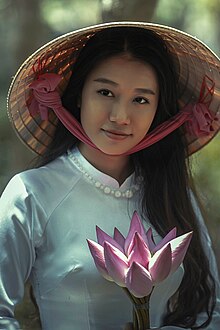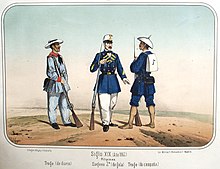Asian conical hat


The Asian conical hat is a simple style of
Regional names
English terms for the hat include sedge hat, rice hat, paddy hat, bamboo hat, and—historically but now
In Southeast Asia, it is known as do'un (ដួន) in Cambodia; caping or seraung in Indonesia; koup (ກຸບ) in Laos; terendak in Malaysia; ngop (งอบ) in Thailand; khamauk (ခမောက်) in Myanmar; salakót (ᜐᜎᜃᜓᜆ᜔), sarók, sadók, s'laong, hallidung, kallugong, and tabungaw among other names in the Philippines; and nón lá in Vietnam.[citation needed]
In
.In South Asia, it is known as jaapi (জাপি) in Assam (India); in Bangladesh it is known as mathal (মাথাল).[4]
Use
Asian conical hats are, throughout Asia, primarily used as a form of protection from the sun and rain. When made of straw or other woven materials, it can be dipped in water and worn as an impromptu evaporative cooling device.[5]
China
In China, it was typically associated with farmers, while mandarins wore tighter circular caps, especially in the winter.[6] There are several conical hat types worn during the Qing dynasty (see Qing official headwear).
Japan
It is also widely understood in East Asia, most notably Japan, where they were known as kasa, as a symbol of
Sturdier, even metal, variants, known as jingasa (battle kasa), were also worn by samurai and foot-soldiers in Japan, as helmets.[citation needed]
Philippines


In the
The salakót was also commonly worn by native soldiers in the Spanish colonial army. It was adopted by Spanish troops in the early 18th century as part of their campaign uniform. In doing so, it became the direct precursor of the pith helmet (still called salacot or salacco in Spanish and French).[9]
Vietnam
In
Others
In India, Bangladesh[11] and Borneo, the plain conical hat was worn by commoners during their daily work, but more decoratively-colored ones were used for festivities. In Sabah, the colorful conical hat is worn for certain dances while in Assam they are hung in homes as decoration or worn by the upper classes for special occasions.[citation needed]
Gallery
-
A selection of conical hats in Hainan, China
-
Souvenir nón tơi for tourists from Vietnam
-
A silver inlaid Filipino salakót
-
A Korean man in traditional mourning clothes and satgat
-
Making conical hats (nón tơi) in Huế countryside, Vietnam
-
Three Sama-Bajau women wearing saruk from Jolo, Sulu, Philippines, c.1900

See also
- Fulani hat
- Gat
- List of hats and headgear
- Mokoliʻi, an island in Hawaii with a nickname "Chinaman's Hat"
- Ngob
- Pointed hat
- Pilgrim's hat
References
- ^ "Definition of COOLIE". www.merriam-webster.com. Retrieved January 5, 2022.
- ^ "Definition of coolie | Dictionary.com". www.dictionary.com. Retrieved January 5, 2022.
- ^ "Coolie hat - Definition and More from the Free Merriam-Webster Dictionary".
- ^ "Bamboo Craft". Banglapedia.
- ^ "Conical Hats". Nguyentientam.com. Retrieved May 23, 2012.
- ^ Chisholm, Hugh, ed. (1911). . Encyclopædia Britannica. Vol. 17 (11th ed.). Cambridge University Press. pp. 55–559, see page 558, lines 3 to 5.
The term 'mandarin' is ...[applied]... only to those who are entitled to wear a 'button,' which is a spherical knob, about an inch in diameter, affixed to the top of the official cap or hat
- ^ Peralta, Jesus T. (2013). Salakot and Other Headgear (PDF). National Commission for Culture and the Arts (NCCA) & Intangible Cultural Heritage in the Asia-Pacific Region (ICHCAP), UNESCO. p. 232.
- ^ Nocheseda, Elmer I. "The Filipino And The Salacot". Tagalog Dictionary. Retrieved March 3, 2020.
- ^ Antón, Jacinto (December 5, 2013). "La romántica elegancia de Salacot". El País. Archived from the original on April 3, 2017. Retrieved May 3, 2018 – via elpais.com.
- ^ "Vietnamese Costumes: Non toi".
- ^ মৃত্যুঞ্জয় রায় (April 17, 2022). "বাংলার মাথাল" [Mathal of Bengal]. Daily Naya Diganta (in Bengali). Dhaka, Bangladesh. Retrieved November 14, 2023.












